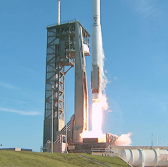 A communications satellite that Boeing built for NASA lifted off Friday aboard a United Launch Alliance’s Atlas V rocket.
A communications satellite that Boeing built for NASA lifted off Friday aboard a United Launch Alliance’s Atlas V rocket.
Atlas V sent the Tracking and Data Relay Satellite-M into orbit after the latter separated from the rocket that took off at 8:29 a.m. Eastern time from Cape Canaveral Air Force Station in Florida, NASA said Friday.
TDRS-M is the final communications satellite in the series to join NASA’s Space Network that works to provide high-bandwidth communications and navigation support to the Hubble Space Telescope, International Space Station, space vehicles and rockets.
Boeing will conduct checkout and testing operations for four months before the satellite enters into service by early 2018.
The new satellite aims to “expand the capabilities and extend the lifespan of the Space Network, allowing us to continue receiving and transmitting mission data well into the next decade,†said Dave Littmann, TDRS project manager at NASA’s Goddard Space Flight Center in Maryland.
Boeing said Friday TDRS-M serves as the sixth TDRS platform the company developed for NASA through its El Segundo, California-based facility.
Enrico Attanasio, executive director for Defense Department and civil programs at Boeing’s satellite system business, said the TDRS-M satellite’s launch seeks to reflect the company’s four-decade partnership with NASA and commitment to build technology platforms in support of the agency’s deep space missions.




